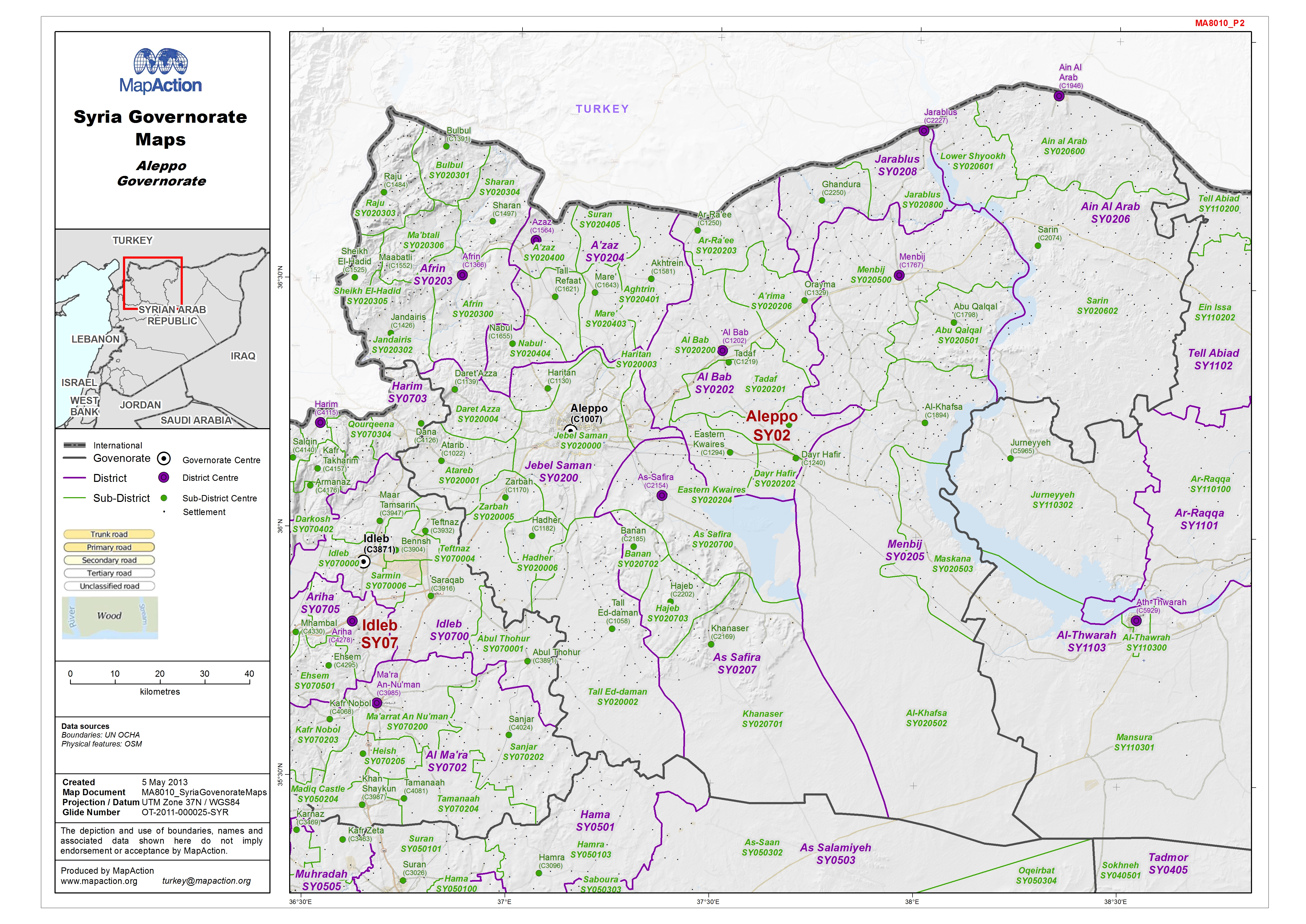 Syria Governorate Maps - Aleppo Governorate
Syria Governorate Maps - Aleppo Governorate
The depiction of administrative boundaries, with p-coded (place code) labels where appropriate, is invariably highly important for multiple aspects of information management in support of humanitarian decision-making. This is because it encourages and enables situational data to be aggregated using a consistent framework, and so facilitates analysis. It is essential that administrative boundaries, with any associated p-codes, are standardised across institutions and agencies involved in the response.
Early on in a response it may only be possible to obtain level 0 (International) or level 1 (province, municipality) information, but the more detailed the boundaries, the more granular the analysis can be, so using level 2 (district/zone), level 3 (territory/city), or level 4 (village) becomes more important as a response evolves.
Strategic or operational?
Strategic and operational.
Basemap, baseline or situational?
Basemap.
When might it be produced?
The depiction of administrative boundaries, with p-coded labels where appropriate, is invariably highly important for multiple aspects of information management to support humanitarian decision-making. This is because it encourages and enables situational data to be aggregated using a consistent spatial framework, and so facilitates analysis.
Intended audience
Everyone.
Influence on humanitarian decisions
The depiction of administrative boundaries, with p-coded labels where appropriate, is invariably highly important for multiple aspects of information management to support humanitarian decision-making. This is because it encourages and enables situational data to be aggregated using a consistent spatial framework, and so facilitates analysis.
Methods
- Maps styles will vary according to the audience and intended use:
- basic - black and white or grey scale map with just administrative boundaries: easy to photocopy, users can add their own information over the top.
- advanced - full colour reference, office wall type map: users are likely to be planning operations with it and need as much detail as possible.
- Create a gazetteer and lookup for settlements, particularly if there are many settlements. This will enable the user to find locations more quickly and efficiently, particularly when there are hundreds or thousands of locations.
- Use data driven pages, or at the very least have this in mind.
- Plan to produce three or more levels of maps: (1) country; (2) administrative level 1 map series; (3) administrative level 2 map series, each with increasing levels of detail if required.
- Administrative boundaries and p-code maps should be used as a base for almost all products.
Data
It is essential that administrative boundaries, with any associated p-codes, are standardised across in- stitutions and agencies involved in the response. The starting point will normally be the common opera- tional datasets. OCHA information management staff will normally have stewardship of these datasets, and should be consulted to ensure that the version used in mapping is consistent with that in use for data collection and other purposes.
Administrative Boundaries
- Global Administrative Areas (GADM) - accurate global coverage of administration boundaries from level 0 to level 2. Can be downloaded in multiple GIS formats.
- Global Administrative Unit Layers (GAUL) - global coverage of administrative boundaries. Each country varies in the number of administrative levels that are included, from level 0 to level 5.
- Large Scale International Boundaries (LSIB) - accurate international boundary level data.
- Second Administrative Level Boundaries (SALB) - highly accurate for the countries covered.
Place Codes (p-codes)
- Common Operation Datasets (CODs) - accurate global coverage of administration boundaries from level 0 to level 2. Can be downloaded in multiple GIS formats.
- The Humanitarian Data Exchange
Settlements
Resources
Humanitarian Response has a number of documents that further explain the concept of p-codes and how to create them.